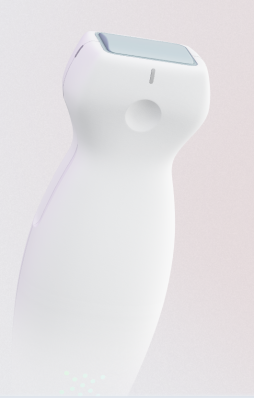
September 26, 2023 — Exo (pronounced “echo”), a medical imaging software and device company, today unveiled a category-redefining handheld ultrasound device, Exo Iris, to put high-performance medical imaging into the hands—and pockets—of every caregiver. Built on Exo’s advanced silicon technology, Exo Iris delivers versatile imaging performance for point-of-care ultrasound (POCUS) at a fraction of the size and cost of cart-based systems. Exo Iris is the latest addition to Exo’s ecosystem, which combines imaging, workflow software, and artificial intelligence (AI) to enable POCUS adoption at a systems-wide scale. Exo Iris gives caregivers—including physicians, nurses, EMTs, and clinicians in emergency, acute care, outpatient, and at-home settings—a window into the human body for immediate answers at the point of care.
“Iris represents a new era of ultrasound,” said Sandeep Akkaraju, CEO and Co-Founder of Exo. “It’s built to perform as easily as taking an image with a smartphone. For caregivers who’ve bemoaned out-of-touch medical technology, you’ve been heard. This device is meant for you and everyone in healthcare—it will save lives, improve patient care, and lower costs. A testament to the transformative power of great design, Iris is the first of many innovations to come that will redefine the medical imaging space. We’re just getting started.”
Exo Iris is Designed for Simplicity and Immediate Answers
Designed around the caregiver, Exo Iris blends a simple user experience with powerful, real-time AI to enable even novice users to get instant answers at their fingertips. The company’s patented SweepAI technology automatically acquires images with a sweep of the caregiver’s wrist, reducing operator dependence and bias to ensure consistent and accurate imaging.
Exo Iris comes equipped with Exo’s Bladder AI solution to help caregivers determine bladder volume in seconds. Exo has a suite of additional AI solutions coming soon, including FDA 510k-pending advanced Cardiac and Lung AI suites that provide real-time guidance and answers for caregivers to quickly and accurately diagnose, triage, and monitor heart and pulmonary conditions.
“Exo Iris is so remarkably simple to pick up and use—the entire ecosystem is built around the POCUS user and how they want to work,” said Arun Nagdev, M.D., Senior Director of Clinical Education at Exo. “Exo Iris delivers an entirely new approach to the design of ultrasound; one that doesn’t look at ultrasound as a device-only purchase, but seamlessly brings together a complete solution that includes imaging, workflow, and real-time AI in one platform.”
Exo Iris Delivers Point-of-Care Answers with Breakthrough Technology
Exo Iris is powered by Exo’s patented pMUT-based technology that blends the imaging excellence of piezoelectric crystals with silicon’s affordability. Exo’s silicon architecture allows for rapid imaging quality evolution and delivers real-time AI capabilities where every frame can be analyzed to guide the user to an immediate answer.
With this industry-first technology, Exo Iris delivers unparalleled sensitivity for seeing deeper into the body or tracking fine structures, enabling caregivers to scan all major organs and guide IVs and line procedures. In addition, caregivers have access to industry-leading features like ultra-wide field of view for imaging up to 150 degrees, allowing them to capture an entire liver or full-body fetus in a single view.
Exo Iris Easily Integrates with Any Healthcare IT System
Hospitals can easily connect Exo Iris to existing healthcare IT systems for compliance and storage, whether it be their PACS or VNA. They can also store exams on Exo’s secure cloud environment. Additionally, Exo Iris can function without an internet connection, making it essential for caregivers in rural settings and in mobile response. Exo Iris comes equipped with Exo’s point-of-care ultrasound workflow solution, Exo Works, to seamlessly document and review exams in seconds from anywhere. This combination blends an entire medical imaging ecosystem to perform flawlessly across hospitals, clinics, and at home, making communication across all spectrums of care possible. With Exo enabling system-wide adoption, health organizations finally have an answer for enterprise-level POCUS investment.
Exo Iris’ platform meets the highest bar for patient data security. It is HITRUST, HIPAA, SOC2 Type II compliant, and ISO 27001 certified. IT departments can rest assured of data protection and regulatory compliance.
Exo’s Ecosystem Will Create New Care Pathways
Exo Iris is another giant step towards Exo’s mission of bringing medical imaging everywhere through its simple and accessible ecosystem that delivers immediate answers at the point of care. Exo’s imaging platform enables caregivers to retrieve quick, accurate, and affordable imaging in any setting with Exo Iris, spend less time on administrative work and more time on delivering care with Exo Works, and easily acquire consistent and accurate images with real-time AI.
“Exo Iris has exceeded all my expectations in the quality of its imaging. I can identify both normal and abnormal conditions in organs throughout the body right at the point of care,” said Richard Popp, M.D., Professor of Medicine (Emeritus) at Stanford University and Head of Exo’s Advisory Board. “In combination with Exo’s developed AI capabilities, Exo Iris will be useful for people beyond what is available today. Now patients with chronic conditions can be monitored at home after they leave the hospital using point-of-care ultrasound with AI assistance. Technology this powerful will improve patient care in ways that we can’t even predict. Who knew how we’d use the iPhone now? With Exo Iris being affordable, high-quality, and immediately accessible, colleagues like mine and other specialists will be able to expand our own use of ultrasound—using it in clinics everywhere, all day long.”
For more information: https://www.exo.inc/iris


 December 24, 2025
December 24, 2025 









